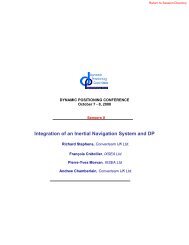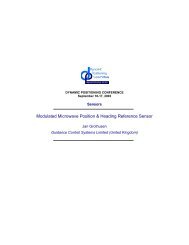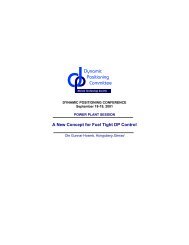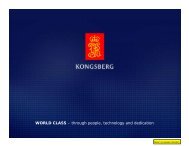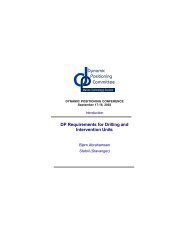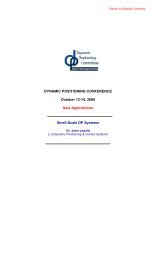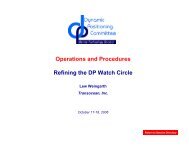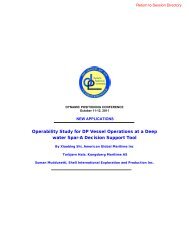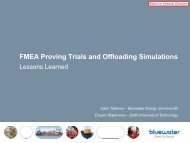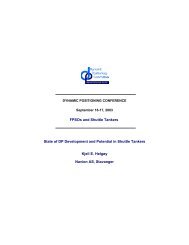Time Domain Simulation of DP Semi-Submersibles in Numerical Wave
Time Domain Simulation of DP Semi-Submersibles in Numerical Wave
Time Domain Simulation of DP Semi-Submersibles in Numerical Wave
You also want an ePaper? Increase the reach of your titles
YUMPU automatically turns print PDFs into web optimized ePapers that Google loves.
Author’s Name Name <strong>of</strong> the Paper SessionDYNAMIC POSITIONING CONFERENCESeptember 16-17, 2003<strong>DP</strong> Design and Control System 2<strong>Time</strong> <strong>Doma<strong>in</strong></strong> <strong>Simulation</strong> <strong>of</strong> <strong>DP</strong> <strong>Semi</strong>-<strong>Submersibles</strong> <strong>in</strong> <strong>Numerical</strong><strong>Wave</strong>-Tank for Large Nonl<strong>in</strong>ear Random <strong>Wave</strong>sNagan Sr<strong>in</strong>ivasanABS-Americas Division, Houston,Debabrata SenIndian Institute <strong>of</strong> Technology, India
Return to Session DirectoryNagan Sr<strong>in</strong>ivasan & Debabrata Sen, ABS & IIT<strong>Time</strong> <strong>Doma<strong>in</strong></strong> <strong>Simulation</strong> <strong>of</strong> <strong>DP</strong> <strong>Semi</strong>-submersiblesTIME-DOMAIN SIMULATION OF <strong>DP</strong> SEMISUBMERSIBLESIN NUMERICAL WAVE-TANK FORLARGE NONLINEAR RANDOM WAVESNagan Sr<strong>in</strong>vasan 1 and Debabrata Sen 21 ABS-Americas Division, Houston, Texas, USA2 Indian Institute <strong>of</strong> Technology, Kharagpur, IndiaABSRACTIn deepwater, Dynamic Position<strong>in</strong>g (<strong>DP</strong>) is proved to be cost-effective for the station keep<strong>in</strong>g andcontroll<strong>in</strong>g <strong>of</strong> the float<strong>in</strong>g structures. This paper will show that the <strong>DP</strong> simulation and control <strong>of</strong> afloat<strong>in</strong>g vessel can be achieved <strong>in</strong> a numerical wave-tank. The complex <strong>in</strong>teraction <strong>of</strong> the w<strong>in</strong>d,waves and current forces aga<strong>in</strong>st the vessel is modeled for the required station position<strong>in</strong>g withthe application <strong>of</strong> controlled propulsion system. The <strong>DP</strong> simulation and control <strong>in</strong> a numericalwave tank will be very useful to the <strong>of</strong>fshore <strong>in</strong>dustry <strong>in</strong> terms <strong>of</strong> <strong>DP</strong> system design verificationand <strong>in</strong> terms <strong>of</strong> the vessel design with the maximum <strong>DP</strong> forces load<strong>in</strong>g condition. In this paper,we discuss a truly dynamic time-doma<strong>in</strong> simulation method for a fully <strong>DP</strong> assisted semisubmersible.The computational algorithm for the simulation is based on the concept <strong>of</strong> anumerical wave-tank. For the basic potential flow solver <strong>in</strong>clud<strong>in</strong>g diffraction and radiationeffects, a boundary <strong>in</strong>tegral method <strong>in</strong> conjunction with time-<strong>in</strong>tegration <strong>of</strong> boundary conditionsand equation <strong>of</strong> body motions is used. Nonl<strong>in</strong>ear effects associated with large amplitude wavesand other relevant non-l<strong>in</strong>earities that affect the motions <strong>of</strong> the body are <strong>in</strong>cluded <strong>in</strong> thealgorithm. Morison elements with braces are represented without any approximation <strong>in</strong> the sensethat these are determ<strong>in</strong>ed based on nonl<strong>in</strong>ear wave k<strong>in</strong>ematics and the exact wetted part <strong>of</strong> theelements. The current and w<strong>in</strong>ds are based on empirical relations as is the present standard, butcan consider spatial (<strong>in</strong> particular, depth) variations <strong>of</strong> velocities. Simulated time histories <strong>of</strong>motions and required <strong>DP</strong> thrust are shown for two semi-submersible configurations. The resultsshow that the <strong>DP</strong> simulation and control <strong>in</strong> a numerical wave tank is a viable alternate to the reallife test.INTRODUCTIONAs the <strong>of</strong>fshore <strong>in</strong>dustry moves <strong>in</strong>to deeper waters, the design <strong>of</strong> <strong>DP</strong> systems for controll<strong>in</strong>g theposition <strong>of</strong> float<strong>in</strong>g production platforms has become <strong>in</strong>creas<strong>in</strong>gly important. These platforms<strong>of</strong>ten have to work under severe environmental conditions <strong>in</strong>clud<strong>in</strong>g effects <strong>of</strong> currents, w<strong>in</strong>dloads and very severe waves. The <strong>DP</strong> system controls the vessel’s motion <strong>in</strong> three horizontaldegrees <strong>of</strong> freedom – surge, sway and yaw. The vessel is held <strong>in</strong> relatively fixed position withrespect to the ocean floor, without us<strong>in</strong>g anchors by the use <strong>of</strong> propulsive devices controlled bythe <strong>in</strong>puts for the desired location aga<strong>in</strong>st w<strong>in</strong>d, wave and current environmental forces on thevessel. In general, the wave <strong>in</strong>duced platform motions can be separated <strong>in</strong>to two majorcomponents, the first order high-frequency motions and the second order low frequency motions.The <strong>DP</strong> systems are usually designed to counter the effects <strong>of</strong> this low frequency component, <strong>in</strong>addition to the effects <strong>of</strong> currents and w<strong>in</strong>d (Barltrop 1998). Efficient and optimal design <strong>of</strong> a <strong>DP</strong>system requires that the necessary <strong>DP</strong> thrust under the comb<strong>in</strong>ed action <strong>of</strong> environmental forcesbe predicted. In a simpler conventional mathematical model where the required <strong>DP</strong> thrusts aresimulated, usually the low-frequency drift force is considered as far as the wave-action isconcerned. If the desired position is predeterm<strong>in</strong>ed, the <strong>DP</strong> systems can be simulated forautomatic position<strong>in</strong>g and head<strong>in</strong>g control <strong>of</strong> a vessel. The American Bureau <strong>of</strong> Shipp<strong>in</strong>g (ABS)Dynamic Position<strong>in</strong>g Conference September 17-18, 2002 Page # - 2 -
Return to Session DirectoryNagan Sr<strong>in</strong>ivasan & Debabrata Sen, ABS & IIT<strong>Time</strong> <strong>Doma<strong>in</strong></strong> <strong>Simulation</strong> <strong>of</strong> <strong>DP</strong> <strong>Semi</strong>-submersiblesThe assumption that has been made <strong>in</strong> the present approach is that nonl<strong>in</strong>ear part <strong>of</strong> the wavediffraction and radiation <strong>in</strong> the total <strong>in</strong>teraction <strong>of</strong> the float<strong>in</strong>g vessel is very small compared tothe l<strong>in</strong>ear diffraction and radiation hydrodynamic-<strong>in</strong>teraction effects. This assumption greatlyreduces the computational burden and makes the method practical for <strong>in</strong>dustry applications torealistic <strong>of</strong>fshore-structure configurations.What is sacrificed here are the nonl<strong>in</strong>ear effects associated with the diffraction and radiation (asmall part the nonl<strong>in</strong>ear effects enters the solution through the body-boundary condition <strong>in</strong> whichthe full nonl<strong>in</strong>ear <strong>in</strong>cident wave-potential is used). Without this l<strong>in</strong>earization approximation, thesolution would have become fully nonl<strong>in</strong>ear. However, at the present time, a fully nonl<strong>in</strong>earsolution algorithm is not available for rout<strong>in</strong>e use for practical <strong>of</strong>fshore configurations. And, suchfull nonl<strong>in</strong>ear schemes would be prohibitively expensive. For most typical float<strong>in</strong>g platforms, thesurface-pierc<strong>in</strong>g parts are cyl<strong>in</strong>drical with relatively small water-plane area (compared to a shipshapedbody), and therefore the non-l<strong>in</strong>earities associated with the diffraction and radiationpotentials are small. It is well documented that the largest part <strong>of</strong> non-l<strong>in</strong>earities arises from the<strong>in</strong>cident wave-effects. For this component, not only a fully nonl<strong>in</strong>ear numerical wave isconsidered, the forces are evaluated on the <strong>in</strong>stantaneous location <strong>of</strong> the body us<strong>in</strong>g the exactwetted surface (for simulation <strong>of</strong> random waves, Wheeler stretch<strong>in</strong>g is used, see e.g. Chakrabarti1987). Thus, the effects <strong>of</strong> regular <strong>in</strong>cidents waves are fully considered without anyapproximation.The equation <strong>of</strong> motion is given by[ ]{&&} = { }m x f (2)Which can be written as a set <strong>of</strong> two l<strong>in</strong>ear differential equations,Where { }[ ]{&} = { }{ } = { }m v f (3)&x v (4)r rv = U , w . The time-history <strong>of</strong> the motionsv is the generalized velocity vector,{ } { G }can be determ<strong>in</strong>ed by <strong>in</strong>tegrat<strong>in</strong>g these equations and establish<strong>in</strong>g at every <strong>in</strong>stant the forces andmotions. Coupl<strong>in</strong>g <strong>of</strong> the <strong>in</strong>tegration <strong>of</strong> equation <strong>of</strong> motion along with the solution <strong>of</strong> thediscretized boundary-<strong>in</strong>tegral relation is not straightforward as it <strong>of</strong>ten leads to numerical<strong>in</strong>stability. Appropriate algorithms have been developed so that the time-simulation scheme isstable. The details <strong>of</strong> the method, the simplify<strong>in</strong>g approximation and its justifications, and thealgorithms used for <strong>in</strong>tegrat<strong>in</strong>g body-motion equations are available <strong>in</strong> Sr<strong>in</strong>ivasan et. al. (1999)and Sen (2002).OTHER FORCESIt is straightforward to <strong>in</strong>corporate effects <strong>of</strong> other forces <strong>in</strong> the motion simulation algorithm. TheMorison forces at any given <strong>in</strong>stant can be determ<strong>in</strong>ed us<strong>in</strong>g the nonl<strong>in</strong>ear <strong>in</strong>cident wavek<strong>in</strong>ematics, the <strong>in</strong>stantaneous location <strong>of</strong> the body and its velocity and acceleration as well as byconsider<strong>in</strong>g the <strong>in</strong>stantaneous wetted part <strong>of</strong> the Morison member (Chakrabarti 1987). This force(and moment) can be added to the force vector { f }. Similarly moor<strong>in</strong>g forces, forces aris<strong>in</strong>gfrom riser and any other forces , which can be empirically modeled or determ<strong>in</strong>ed from otherDynamic Position<strong>in</strong>g Conference September 17-18, 2002 Page # - 4 -
Nagan Sr<strong>in</strong>ivasan & Debabrata Sen, ABS & IITReturn to Session Directory<strong>Time</strong> <strong>Doma<strong>in</strong></strong> <strong>Simulation</strong> <strong>of</strong> <strong>DP</strong> <strong>Semi</strong>-submersiblesmeans, can be directly added to the force vector at every <strong>in</strong>stant. It is also straightforward to<strong>in</strong>corporate nonl<strong>in</strong>ear nature <strong>of</strong> such forces, e.g. when these forces depend on the variablesrelated to the <strong>in</strong>stantaneous location and k<strong>in</strong>ematics as <strong>in</strong> the case <strong>of</strong> nonl<strong>in</strong>ear moor<strong>in</strong>g loads.In the present algorithm, Morison forces, as mentioned above, are exact without approximation.Current forces on the diffraction-elements <strong>of</strong> the structure and w<strong>in</strong>d forces are estimated based onthe formulation <strong>in</strong> Falt<strong>in</strong>sen (1990). Current forces on the Morison elements are determ<strong>in</strong>ed bymodify<strong>in</strong>g the particle velocity by l<strong>in</strong>early add<strong>in</strong>g the wave-velocity and current velocity and thenus<strong>in</strong>g an equivalent l<strong>in</strong>earization <strong>of</strong> the drag force term. Moor<strong>in</strong>g forces presently are modeled asl<strong>in</strong>ear spr<strong>in</strong>g with appropriate stiffness.<strong>DP</strong> THRUSTOne <strong>of</strong> the difficult tasks <strong>of</strong> this <strong>Numerical</strong> <strong>Wave</strong>-Tank <strong>DP</strong> simulation is to simulate the motionsunder the comb<strong>in</strong>ed action <strong>of</strong> wave, current, w<strong>in</strong>d and the applied <strong>DP</strong> thrust. W<strong>in</strong>d, wave andcurrent are user def<strong>in</strong>ed based on the environmental design criteria. At first <strong>DP</strong> is a totalunknown. However, the <strong>DP</strong> must be such that under its application along with all other forc<strong>in</strong>g,the structure ma<strong>in</strong>ta<strong>in</strong>s a given position with m<strong>in</strong>imum excursion from it. The required <strong>DP</strong> thrustmust be determ<strong>in</strong>ed from a control system algorithm. The vessel can be controlled <strong>in</strong> severaldifferent modes: Manual, Auto-Head<strong>in</strong>g, Auto-Position<strong>in</strong>g, Auto-Area, Auto-Track, Auto-Pilotand Follow-Target. Hence the target position could be determ<strong>in</strong>ed at each time step. Or a PIDmethod could be used for its m<strong>in</strong>imum excursion <strong>of</strong> the vessel from its mean zero start<strong>in</strong>greference position.As it is not usually possible for the thrusters to control the high-frequency cyclic motions <strong>in</strong>ducedby first order wave effects, the <strong>DP</strong> thrusts are determ<strong>in</strong>ed consider<strong>in</strong>g only m<strong>in</strong>imization <strong>of</strong> thelow-frequency wave motions. To obta<strong>in</strong> low frequency motions, the position reference signalshave to be filtered us<strong>in</strong>g a low pass filter so as to remove the wave-frequency part <strong>of</strong> the motionsfrom the motion signal.There are a number <strong>of</strong> control systems available, from a simple PID type to more advancedpredictor-corrector Kalman filter (Barltrop 1998). In the PID system, the basic pr<strong>in</strong>ciple is toproduce thrust which has components ∆x proportional to the error <strong>in</strong> the vessel location, itsvelocity and the accumulated error, all at time t (se e.g. Nienhuis 1986). Thus the required thrustis:F = F + c∆ x + b∆ x& + a ∆xdt(5)<strong>DP</strong>s∫tIn which, a, b and c are the proportional, differential and <strong>in</strong>tegral constants, respectively. Theyare used to adjust the rate <strong>of</strong> response <strong>of</strong> the system to measure errors and to control unstable oroscillatory behavior. The rate <strong>of</strong> response is controlled by the proportional and <strong>in</strong>tegral terms.Higher rate <strong>of</strong> response is achieved by <strong>in</strong>creas<strong>in</strong>g the constant terms c and a. Overshoots, cyclicor unstable motions would occur if the response is too rabid and the damp<strong>in</strong>g term b is notproperly tuned. Excessive damp<strong>in</strong>g, however, will make the response sluggish. In fact, <strong>Numerical</strong><strong>Wave</strong> Tank <strong>Simulation</strong> is very useful to select these parameters for the f<strong>in</strong>al tun<strong>in</strong>g on the actualvessel at sea. The primary requirement <strong>of</strong> this PID system is that it has to be used <strong>in</strong> conjunctionwith a low pass filter to remove the high-frequency motions from the position signals. This<strong>in</strong>variably <strong>in</strong>troduces a phase lag. The design <strong>of</strong> a filter always <strong>in</strong>volves a compromise betweengood filter<strong>in</strong>g and good response. Several criteria are available for design<strong>in</strong>g a good filter.Dynamic Position<strong>in</strong>g Conference September 17-18, 2002 Page # - 5 -
Nagan Sr<strong>in</strong>ivasan & Debabrata Sen, ABS & IITReturn to Session Directory<strong>Time</strong> <strong>Doma<strong>in</strong></strong> <strong>Simulation</strong> <strong>of</strong> <strong>DP</strong> <strong>Semi</strong>-submersiblesKalman filter approach follows from a predictor-corrector type <strong>of</strong> computer model, where thevessel motion as predicted from a computer model is compared with the measured response. Thethrust is then <strong>in</strong> proportion to the error, which is taken as the difference between the predicted andmeasured response. In Kalman filter technique, the low and high frequency motions areseparated. The computer prediction models are written separately to simulate the vessel motionsunder low-frequency forces and high frequency forces. This filter is useful dur<strong>in</strong>g actualoperation, as here the measured vessel motions are needed for the corrector part <strong>of</strong> the algorithm.In the present example demonstration study, we use the simpler PID control algorithm for thecontrol system <strong>in</strong> our numerical simulation model. The low pass filter<strong>in</strong>g is performed by amov<strong>in</strong>g average type <strong>of</strong> filter. In the numerical tank simulation, the motions and all details areavailable at every time step, typically over 20-40 steps per wave frequency. The high frequencymotions are removed by averag<strong>in</strong>g the signals over the past N time steps, where N is chosen suchas to span over 3-4 wave-cycles. Although much improvement on the design <strong>of</strong> the filter can bemade, here our primary purpose is to demonstrate the ability <strong>of</strong> the numerical algorithm <strong>in</strong>simulat<strong>in</strong>g motions along with <strong>DP</strong> thrusts under the comb<strong>in</strong>ed action <strong>of</strong> all environmental andexternal forces. The response is simulated consider<strong>in</strong>g an advanced model for wave action alongwith other possibly <strong>in</strong>teract<strong>in</strong>g effects.RESULTS AND DISCUSSIONThe first set <strong>of</strong> simulation results are for a tw<strong>in</strong>-pontoon four-cyl<strong>in</strong>der semi-submersible. Thepontoons are 90m*15m*6.5m and cyl<strong>in</strong>ders are 9 m dia. There are 13 Morison members <strong>of</strong>average dia. <strong>of</strong> 1m. Figure 2 shows the semi-submersible <strong>in</strong> the numerical wave tank with randomwave environment. Figure 3 shows the simulation results for the case <strong>of</strong> an irregular head wavewith 0 deg. head<strong>in</strong>g (i.e. along x-direction) and significant wave height <strong>of</strong> Hs=4m. for the cases<strong>of</strong> no moor<strong>in</strong>g or <strong>DP</strong>, s<strong>of</strong>t and hard moor<strong>in</strong>g, and with <strong>DP</strong> work<strong>in</strong>g. As can be seen, without anymoor<strong>in</strong>g or <strong>DP</strong>, the body drifts along surge direction. The performance <strong>of</strong> the moor<strong>in</strong>g and <strong>DP</strong>system is comparable. (The moor<strong>in</strong>g is a spread-moor<strong>in</strong>g system with four l<strong>in</strong>es.). Although nocurrent and w<strong>in</strong>ds are considered for this result, with current and w<strong>in</strong>d, the results are <strong>of</strong> similarnature except that the drift is far greater when no position controller is used, as would beexpected.In Figure 4, we show the simulation result with <strong>DP</strong> work<strong>in</strong>g <strong>in</strong> presence <strong>of</strong> a 1 m/s current alongx-direction for the same wave condition. The <strong>of</strong>fset <strong>in</strong> the surge position is a consequence <strong>of</strong> thefact that no mean thrust to compensate for the mean steady current load has been applied (i.e. theterm F s <strong>in</strong> equation 5 is zero).Figure 5 shows the results with a mean load (<strong>of</strong> 1000 kN). In all results, the <strong>in</strong>itial transientobta<strong>in</strong>ed from numerical tank program is reta<strong>in</strong>ed to demonstrate that the displacement and thrustvalues eventually reach the desired value (i.e. a value with small changes). The <strong>in</strong>itial transient <strong>in</strong>the thrust value 1000kn seen <strong>in</strong> figure 5 was due to the thrust <strong>of</strong> 1000 kN that was applied us<strong>in</strong>g aramp function. This is done to avoid any numerical <strong>in</strong>stability problem that could have arisendur<strong>in</strong>g the numerical time-<strong>in</strong>tegration process. Note that <strong>in</strong> both figure 4 and figure 5, thrust valuereached is <strong>of</strong> the same order. Figure 5 shows that surge is with<strong>in</strong> 1 m.Figure 6 shows that result for a wave head<strong>in</strong>g <strong>of</strong> 45 deg. and a current head<strong>in</strong>g <strong>of</strong> about 30 deg.(current head<strong>in</strong>gs are taken such that the estimated mean current loads are 1000kN and 500kN <strong>in</strong>surge and sway directions respectively). As can be seen, the <strong>DP</strong> is aga<strong>in</strong> able to keep the vesselposition with<strong>in</strong> 1 m. with m<strong>in</strong>imal variation <strong>in</strong> thrust.Dynamic Position<strong>in</strong>g Conference September 17-18, 2002 Page # - 6 -
Nagan Sr<strong>in</strong>ivasan & Debabrata Sen, ABS & IITReturn to Session Directory<strong>Time</strong> <strong>Doma<strong>in</strong></strong> <strong>Simulation</strong> <strong>of</strong> <strong>DP</strong> <strong>Semi</strong>-submersiblesIn figure 7, the wave is a nonl<strong>in</strong>ear very steep steady wave <strong>of</strong> period 10 sec. and height 10m,progress<strong>in</strong>g along x-direction. Here although the surge is reta<strong>in</strong>ed with<strong>in</strong> about 1 m., thereappears to be a slow oscillation. This is possibly due to the choice <strong>of</strong> the controller constants(c,b,a) <strong>in</strong> eqn. 5, which has not been optimized for performance, as well as for the filter<strong>in</strong>gtechnique used which <strong>in</strong>variably <strong>in</strong>troduces a phase shift. The appearance <strong>of</strong> high frequencyoscillations <strong>in</strong> the thrust is also due to the filter<strong>in</strong>g process: the average-based filter used is unableto filter all high frequency signals. In reality, the applied thrust will not conta<strong>in</strong> this highfrequency component.F<strong>in</strong>ally, we show the simulation results for a triangular semi submersible. The discretization <strong>of</strong>the platform is illustrated <strong>in</strong> figure 8. No Morison members are considered for this body. Resultsshown <strong>in</strong> figure 9 are for random waves <strong>of</strong> significant wave height 6 m. mak<strong>in</strong>g a head<strong>in</strong>g angle<strong>of</strong> 30 deg. Note that the x-axis for this body is taken parallel to one <strong>of</strong> the sides and thus the bodyis not symmetric about surge axis. Current <strong>of</strong> 1 m/s comes from a direction with a head<strong>in</strong>g <strong>of</strong> 45deg. Results are shown for surge, sway and yaw. Note that the yaw angle is extremely smallThe above simulations show that the required thrust for a <strong>DP</strong> system can be studied us<strong>in</strong>g thenumerical wave tank computations <strong>in</strong> which environmental and external forces can be modeledconsiderably more accurately compared to most <strong>of</strong> the exist<strong>in</strong>g the mathematical simulationmodels for <strong>DP</strong> systems. Once the thrusts are determ<strong>in</strong>ed, these can be allocated to differentthrusters.ADVANTAGES OF NUMERICAL WAVE TANK <strong>DP</strong> SYSTEM SIMULAIONThe use <strong>of</strong> Dynamic Position<strong>in</strong>g system is likely to <strong>in</strong>crease with deepwater applications <strong>in</strong> thefuture. Even the permanently placed float<strong>in</strong>g production-platforms <strong>in</strong> deepwater may use <strong>DP</strong>system, <strong>in</strong> assistance to their cost-effective polyester moor<strong>in</strong>gs because <strong>of</strong> the elastic nature <strong>of</strong> thepolyester moor<strong>in</strong>gs. A comb<strong>in</strong>ation <strong>of</strong> <strong>DP</strong> system with polyester moor<strong>in</strong>g could be ideal for aproduction semi-submersible <strong>in</strong> 10,000-ft water depth.The safety and operation <strong>of</strong> the <strong>DP</strong> system should be given top priority <strong>in</strong> deepwater applications.The random external forces have catastrophic peaks <strong>in</strong> the service <strong>of</strong> the vessel <strong>in</strong> the oceanenvironments. Design<strong>in</strong>g the <strong>DP</strong> system for the ma<strong>in</strong>ta<strong>in</strong><strong>in</strong>g <strong>of</strong> the vessel <strong>in</strong> position <strong>in</strong>volvesseveral risks <strong>in</strong> such conditions. Real time test<strong>in</strong>g dur<strong>in</strong>g the sea trail is not a sufficient safety andtest proven criteria. <strong>DP</strong> control and monitor<strong>in</strong>g system is to be designed for these catastrophicpeaks with different comb<strong>in</strong>ations <strong>of</strong> w<strong>in</strong>d, wave and current peak forces <strong>in</strong> different directioncomb<strong>in</strong>ations. On the other hand model tests are not accurate either because <strong>of</strong> the high viscouseffect due to the scale down dimensions.Under these situations, a numerical tank <strong>DP</strong> simulation and control is a very valuable tool.<strong>Numerical</strong> wave tank could be used not only to f<strong>in</strong>d the required <strong>DP</strong> forces for the position<strong>in</strong>g <strong>of</strong>the vessel but could also be used to test the control system for different environmental andoperational conditions. The failure modes and effect analyses could be performed <strong>in</strong> thenumerical wave tank <strong>DP</strong> simulation and control. The effects from human / operator mis-operationcan be studied and could be auto piloted by over ride system if significant consequences areforeseen. The accuracy <strong>of</strong> the control system could be verified with the numerical wave tank <strong>DP</strong>simulation. The new concepts could be tested well with the numerical wave tank <strong>DP</strong> simulation.Constra<strong>in</strong>ts <strong>in</strong> thruster and power systems could be verified <strong>in</strong> the design stage itself.Dynamic Position<strong>in</strong>g Conference September 17-18, 2002 Page # - 7 -
Nagan Sr<strong>in</strong>ivasan & Debabrata Sen, ABS & IITReturn to Session Directory<strong>Time</strong> <strong>Doma<strong>in</strong></strong> <strong>Simulation</strong> <strong>of</strong> <strong>DP</strong> <strong>Semi</strong>-submersiblesFor the design <strong>of</strong> the <strong>DP</strong> vessel, <strong>Numerical</strong> <strong>Wave</strong>-Tank <strong>DP</strong> simulation is a very helpful tool.<strong>Numerical</strong> wave-tank simulation also gives the panel pressure <strong>of</strong> the vessel model for furtherstructural <strong>in</strong>tegrity analyses. Non-l<strong>in</strong>ear regular or random waves could be considered and the<strong>in</strong>stantaneous location and orientation <strong>of</strong> the vessels are used. Random w<strong>in</strong>d and spatial currentforces could be applied. <strong>DP</strong> forces are applied at the location and direction <strong>of</strong> the thrusters for thedesired control system. With the user def<strong>in</strong>ed design environmental forces solution is obta<strong>in</strong>ed ateach time step <strong>of</strong> the motion simulation. The load cases pert<strong>in</strong>ent to <strong>DP</strong> critical thruster forces canalso be studied for the structural <strong>in</strong>tegrity <strong>of</strong> the float<strong>in</strong>g vessel. The total panel pressure and thewave slamm<strong>in</strong>g, deck run-up could be studied. The air gap spatial time history could be obta<strong>in</strong>ed.The worst panel pressure loads could be used for further FEM-structural analysis for yield andbuckl<strong>in</strong>g checks.SUMMARIZING REMARKSOne important component <strong>in</strong> the design <strong>of</strong> the <strong>DP</strong> system for float<strong>in</strong>g production platforms is tocarry out a simulation us<strong>in</strong>g a mathematical model. In general, the mathematical model considersthe vessel response to environmental excitations, together with <strong>DP</strong> thrust. Most exist<strong>in</strong>galgorithms use a simplified mathematical model for environmental forces, and therefore may notadequately represent some <strong>of</strong> the effects <strong>of</strong> these external forces. Examples are severe nonl<strong>in</strong>earresponse that may arise from a very steep wave, <strong>in</strong>corporation <strong>of</strong> some components <strong>of</strong> waveforcessuch as Morison forces (which may be significant), any possible nonl<strong>in</strong>ear <strong>in</strong>teraction andcoupl<strong>in</strong>g effects between the difference forces and responses, etc.In our approach, current and w<strong>in</strong>d forces can also be determ<strong>in</strong>ed from improved models byconsider<strong>in</strong>g their spatial and temporal variations, for example the variation <strong>of</strong> current along depth,and consider<strong>in</strong>g the exact wetted part <strong>of</strong> the hull. From this po<strong>in</strong>t, our numerical wave-tank <strong>DP</strong>simulation represents a significant improvement for simulat<strong>in</strong>g the motions <strong>of</strong> a <strong>DP</strong> controlledvessel. Once the <strong>DP</strong> thrusts are determ<strong>in</strong>ed, the thrust allocation logic can be carried out, and thensimulations can be carried out for different environmental scenarios. As moor<strong>in</strong>g, riser etc all canbe considered <strong>in</strong> the simulation program, control <strong>of</strong> the position us<strong>in</strong>g a comb<strong>in</strong>ation <strong>of</strong> moor<strong>in</strong>gand <strong>DP</strong> can also be studied through appropriate simulation.ACKNOWLEDGEMENTThe <strong>DP</strong> simulation and control was performed by us<strong>in</strong>g the TARANG numerical wave tankanalysis program developed by Indian Institute <strong>of</strong> Technology, Kharagpur, India. Their help isgratefully acknowledged. The first author would like to thank Kenneth L. Richardson, BretMontaruli, Pao-L<strong>in</strong> Tan, Yung-Sup Sh<strong>in</strong> <strong>of</strong> ABS-Americas for their cont<strong>in</strong>ued <strong>in</strong>terest andencouragement.REFERENCESABS Guide for Thrusters and Dynamic Position<strong>in</strong>g Systems, 1994Chakrabarti, S.K. (1987). Hydrodynamics <strong>of</strong> Offshore Structures, Computational MechanicsPublicationFalt<strong>in</strong>sen, O.M. Sea loads on ships and <strong>of</strong>fshore structures, Cambridge Univ. Press, 1990.Float<strong>in</strong>g Structures: a guide for design and structures, Vol. 2, Ch 10: Dynamic position<strong>in</strong>g, editedby N.D.P.Barltrop, The Center for Mar<strong>in</strong>e and Petroleum Technology, Publication 101/98, 1998.Dynamic Position<strong>in</strong>g Conference September 17-18, 2002 Page # - 8 -
Return to Session DirectoryNagan Sr<strong>in</strong>ivasan & Debabrata Sen, ABS & IIT<strong>Time</strong> <strong>Doma<strong>in</strong></strong> <strong>Simulation</strong> <strong>of</strong> <strong>DP</strong> <strong>Semi</strong>-submersiblesNienhuis, Ir. U., `<strong>Simulation</strong> <strong>of</strong> low frequency motions <strong>of</strong> dynamically positioned <strong>of</strong>fshorestructures’, RINA Spr<strong>in</strong>g Meet<strong>in</strong>g, Paper No. 7, 1986.Sen, D., <strong>Time</strong>-doma<strong>in</strong> simulation <strong>of</strong> motions <strong>of</strong> large structures <strong>in</strong> nonl<strong>in</strong>ear waves. Proc. 21stSymp. on Offshore Mechanics and Arctic Eng., Oslo, Norway, 11 p., 2002Sr<strong>in</strong>ivasan, N. & Prasad, J., Critical Assessment <strong>of</strong> the Non-l<strong>in</strong>ear <strong>Time</strong>-doma<strong>in</strong> Diffraction andMotion Analysis for Use <strong>in</strong> the Design <strong>of</strong> a Deep Water <strong>Semi</strong>-submersible Drill<strong>in</strong>g Vessel Proc.18th Symp. on Offshore Mechanics and Arctic Eng., St. John’s, Newfoundland, Canada, 1999Dynamic Position<strong>in</strong>g Conference September 17-18, 2002 Page # - 9 -
Return to Session DirectoryNagan Sr<strong>in</strong>ivasan & Debabrata Sen, ABS & IIT<strong>Time</strong> <strong>Doma<strong>in</strong></strong> <strong>Simulation</strong> <strong>of</strong> <strong>DP</strong> <strong>Semi</strong>-submersiblesVessel ModelW<strong>in</strong>d<strong>Wave</strong>CurrentThruster /Forces<strong>Numerical</strong> <strong>Wave</strong>TankFree-SurfacePanel ModelMixed Low and High Freq.Response 6 D.O.FOptimumThrusterAllocationTotalRequiredThrusterForceandMomentLow Pass FilteredVessel ResponseSurge/Sway/Yaw/OrientationPredictor-Corrector /PIDDesiredLocation /Select a Control-System:Auto-Head<strong>in</strong>g /Auto-Position /Auto-Track /Auto-Pilot /Follow-Target /Joy-Stick /Auto-AreaFigure 1 <strong>Numerical</strong> <strong>Wave</strong> Tank <strong>Simulation</strong><strong>of</strong> <strong>DP</strong> SystemDynamic Position<strong>in</strong>g Conference September 17-18, 2002 Page # - 10 -
Return to Session DirectoryNagan Sr<strong>in</strong>ivasan & Debabrata Sen, ABS & IIT<strong>Time</strong> <strong>Doma<strong>in</strong></strong> <strong>Simulation</strong> <strong>of</strong> <strong>DP</strong> <strong>Semi</strong>-submersiblesFigure 2. A 3D View <strong>of</strong> the <strong>Semi</strong>-submersible <strong>in</strong> <strong>Numerical</strong> <strong>Wave</strong> Tank<strong>Simulation</strong> for Random <strong>Wave</strong>sno moor<strong>in</strong>g s<strong>of</strong>t moor<strong>in</strong>g hard moor<strong>in</strong>g <strong>DP</strong>252015x (m)1050-50 50 100 150 200 250 300 350<strong>Time</strong> (sec)Figure 3. Surge displacements for different moor<strong>in</strong>g and <strong>DP</strong>; Hs = 4m.,head<strong>in</strong>g=0 deg.Dynamic Position<strong>in</strong>g Conference September 17-18, 2002 Page # - 11 -
Return to Session DirectoryNagan Sr<strong>in</strong>ivasan & Debabrata Sen, ABS & IIT<strong>Time</strong> <strong>Doma<strong>in</strong></strong> <strong>Simulation</strong> <strong>of</strong> <strong>DP</strong> <strong>Semi</strong>-submersiblesX (m)25201510500 50 100 150 200 250 300 350<strong>Time</strong> (sec)Thrust (kN)2.00E+020.00E+00-2.00E+02 0 50 100 150 200 250 300 350-4.00E+02-6.00E+02-8.00E+02-1.00E+03-1.20E+03<strong>Time</strong> (Sec)Figure 4. Surge displacement and <strong>DP</strong> thrust; Hs = 4m, head<strong>in</strong>g = 0deg., current =1m/s, no <strong>in</strong>itial steady mean thrust .x (m)1.510.50-0.50 50 100 150 200 250 300 350<strong>Time</strong> (Sec)0.00E+000 50 100 150 200 250 300 350-2.00E+02Thrust (kN)-4.00E+02-6.00E+02-8.00E+02-1.00E+03-1.20E+03<strong>Time</strong> (sec)Figure 5. Surge displacement and <strong>DP</strong> thrust; Hs = 4m, head<strong>in</strong>g = 0deg., current =1m/s, <strong>in</strong>itial steady mean thrust <strong>of</strong> 1000 kN.Dynamic Position<strong>in</strong>g Conference September 17-18, 2002 Page # - 12 -
Return to Session DirectoryNagan Sr<strong>in</strong>ivasan & Debabrata Sen, ABS & IIT<strong>Time</strong> <strong>Doma<strong>in</strong></strong> <strong>Simulation</strong> <strong>of</strong> <strong>DP</strong> <strong>Semi</strong>-submersiblesx (m)10.80.60.40.20-0.20 50 100 150 200 250 300 350<strong>Time</strong> (sec)0.00E+000 50 100 150 200 250 300 350-2.00E+02X Thrust (kN)-4.00E+02-6.00E+02-8.00E+02-1.00E+03-1.20E+03<strong>Time</strong> (sec)1Y (m)0.500 50 100 150 200 250 300 350-0.5<strong>Time</strong> (sec)0.00E+000 50 100 150 200 250 300 350-1.00E+02Y Thrust (kN)-2.00E+02-3.00E+02-4.00E+02-5.00E+02-6.00E+02<strong>Time</strong> (sec)Figure 6. Surge and sway displacements and thrust, Hs=4m, wave head<strong>in</strong>g 45 deg.,current <strong>of</strong> 1m/s with an (approximate) head<strong>in</strong>g <strong>of</strong> 30 deg.Dynamic Position<strong>in</strong>g Conference September 17-18, 2002 Page # - 13 -
Return to Session DirectoryNagan Sr<strong>in</strong>ivasan & Debabrata Sen, ABS & IIT<strong>Time</strong> <strong>Doma<strong>in</strong></strong> <strong>Simulation</strong> <strong>of</strong> <strong>DP</strong> <strong>Semi</strong>-submersiblesx (m)21.510.50-0.5 0 50 100 150 200 250 300 350-1-1.5<strong>Time</strong> (sec)Thrust (kN)0.00E+00-2.00E+02 0 50 100 150 200 250 300 350-4.00E+02-6.00E+02-8.00E+02-1.00E+03-1.20E+03-1.40E+03<strong>Time</strong> (sec)Figure 7: Surge displacement and thrust for a very steep nonl<strong>in</strong>ear regular wave <strong>of</strong>period 10 sec. And height 10 m, wave head<strong>in</strong>g 0 deg., current 1m/s.Figure 8. The triangular semi-submersible : discretizationDynamic Position<strong>in</strong>g Conference September 17-18, 2002 Page # - 14 -
Return to Session DirectoryNagan Sr<strong>in</strong>ivasan & Debabrata Sen, ABS & IIT<strong>Time</strong> <strong>Doma<strong>in</strong></strong> <strong>Simulation</strong> <strong>of</strong> <strong>DP</strong> <strong>Semi</strong>-submersibles1510x (m)50-5 0 20 40 60 80 100 120 140 160 180<strong>Time</strong> (sec)5.00E+020.00E+000-5.00E+0220 40 60 80 100 120 140 160 180X Thrust-1.00E+03-1.50E+03-2.00E+03-2.50E+03-3.00E+03<strong>Time</strong> (sec)Y (m)1086420-2 0 20 40 60 80 100 120 140 160 180<strong>Time</strong> (sec)y (m)5.00E+020.00E+000-5.00E+0220 40 60 80 100 120 140 160 180-1.00E+03-1.50E+03-2.00E+03<strong>Time</strong> (sec)yaw (rad.)0.0010-0.001 0 20 40 60 80 100 120 140 160 180<strong>Time</strong> (sec)Figure 9. Surge, sway and yaw displacements and D thrust for the triangular semisubmersible; Hs=6m, head<strong>in</strong>g = 45 deg., current 1m/s with head<strong>in</strong>g 30 deg.Dynamic Position<strong>in</strong>g Conference September 17-18, 2002 Page # - 15 -



